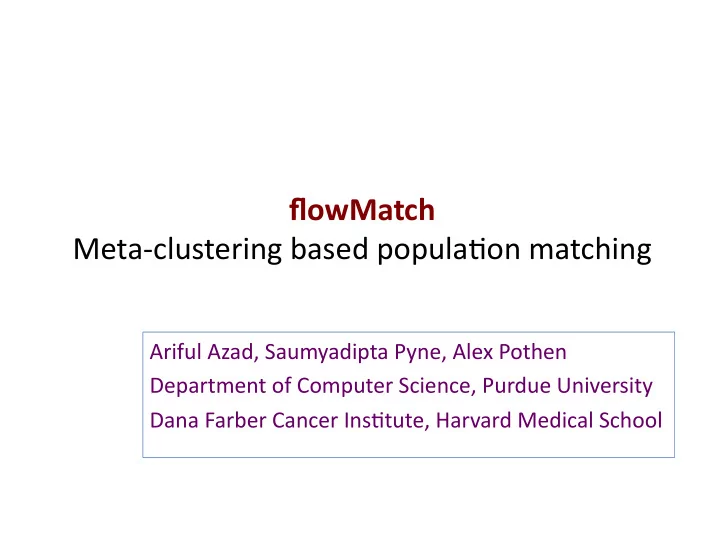

flowMatch ¡ ¡ Meta-‑clustering ¡based ¡popula3on ¡matching ¡ Ariful ¡Azad, ¡Saumyadipta ¡Pyne, ¡Alex ¡Pothen ¡ ¡ Department ¡of ¡Computer ¡Science, ¡Purdue ¡University ¡ Dana ¡Farber ¡Cancer ¡Ins3tute, ¡Harvard ¡Medical ¡School ¡ ¡ ¡
Flow ¡Cytometry ¡– ¡Toy ¡example ¡ CD4 ¡ CD8 ¡ Cell-‑1 ¡ 3 ¡ 1 ¡ Cell-‑2 ¡ 12 ¡ 1 ¡ Cell-‑3 ¡ 3.3 ¡ 4.4 ¡ ….. ¡ … ¡ … ¡ Popula3on ¡ Clustering ¡ ScaNer ¡plot ¡
Challenge-‑4: ¡Correlated ¡popula3ons ¡ across ¡treatment ¡arms ¡ ¡ Time ¡= ¡t ¡ Time ¡= ¡0 ¡ Treatment -‑1 ¡ Treatment -‑1 ¡ Corresponding ¡ ¡ popula<ons ¡ Healthy ¡ Healthy ¡ Treatment -‑2 ¡ Treatment -‑2 ¡ Correspondence ¡ preserved ¡
Three ¡samples ¡of ¡a ¡class ¡at ¡each ¡3me ¡point ¡ Treatment-‑1 ¡ Sample ¡comparison ¡ Treatment-‑2 ¡
Approach: ¡Two ¡Levels ¡ 1. Lower ¡Level: ¡ Registra3on ¡of ¡popula3ons ¡ (clusters) ¡across ¡each ¡pair ¡of ¡samples ¡ 2. Upper ¡Level: ¡Overall ¡representa3on ¡of ¡ samples ¡of ¡a ¡par3cular ¡class ¡using ¡Templates. ¡
1. ¡Registra3on/matching ¡of ¡popula3on ¡ across ¡a ¡given ¡pair ¡of ¡Samples ¡ • A ¡ generalized ¡ edge ¡ cover ¡ (GEC) ¡ is ¡ an ¡ edge ¡ cover ¡ which ¡ allows ¡few ¡uncovered ¡ver3ces ¡at ¡the ¡cost ¡of ¡a ¡penalty ¡(λ). ¡ ¡ • Objec3ve ¡func3on: ¡ ¡ ¡ ¡EC ¡ ¡GEC ¡ Sample-‑2 ¡ Sample-‑1 ¡ Sample-‑1 ¡ Sample-‑2 ¡ Sample-‑2 ¡ Sample-‑1 ¡
2. ¡Instead ¡of ¡comparing ¡popula3ons/ clusters ¡sample ¡by ¡sample ¡… ¡ ¡ Class ¡-‑ ¡A ¡ Sample ¡– ¡A 2 ¡ Sample ¡– ¡A 3 ¡ Sample ¡-‑ ¡A 1 ¡ Sample ¡comparison ¡ Sample ¡– ¡B 2 ¡ Sample ¡– ¡B 1 ¡ Sample ¡– ¡B 3 ¡ Class ¡-‑ ¡B ¡
We ¡can ¡compare ¡meta-‑clusters ¡across ¡templates ¡ Class ¡-‑ ¡A ¡ Template ¡-‑ ¡A ¡ Template ¡comparison ¡ Template ¡-‑ ¡B ¡ Class ¡-‑ ¡B ¡
How ¡to ¡create ¡a ¡template ¡from ¡a ¡pair ¡of ¡ samples ¡ ¡ c 1 ¡ c 1 ¡ c’ 1 ¡ c’ 1 ¡ m 1 ¡ Meta-‑cluster ¡ c’ 2 ¡ c 2 ¡ c’ 2 ¡ m 2 ¡ c 2 ¡ c’ 3 ¡ c 3 ¡ c’ 3 ¡ c 3 ¡ c’ 4 ¡ m 3 ¡ c 4 ¡ c’ 4 ¡ c 4 ¡ m 4 ¡ Sample-‑2 ¡ Sample-‑1 ¡ Template(1,2) ¡
How ¡to ¡create ¡template ¡for ¡a ¡class ¡by ¡ hierarchical ¡merging ¡ GEC ¡ Merge ¡most ¡similar ¡pair ¡of ¡current ¡samples ¡ ¡ GEC ¡
What ¡we ¡did : ¡Correlated ¡popula3ons ¡ across ¡treatment ¡arms ¡ ¡ At ¡each ¡3me ¡point ¡create ¡dis3nct ¡templates ¡ for ¡each ¡of ¡the ¡three ¡classes ¡of ¡samples ¡ ¡ Match ¡templates ¡across ¡3me ¡points ¡to ¡follow ¡ the ¡progression ¡of ¡popula3ons ¡defined ¡by ¡the ¡ corresponding ¡meta-‑clusters. ¡ ¡ Popula3ons ¡are ¡correlated ¡across ¡treatment ¡if ¡ correspondence ¡of ¡meta-‑clusters ¡is ¡preserved. ¡
Correlated ¡popula3ons ¡across ¡ treatment ¡arms ¡ ¡ T=12 ¡ T=0 ¡ T=4 ¡ T=24 ¡ T=72 ¡ 5 ¡ 4 ¡ 2 ¡ 7 ¡ 4 ¡ Copaxone ¡ ¡ Interferon ¡ 8 ¡ 8 ¡ 6 ¡ 7,9 ¡ 6,7 ¡ ¡beta ¡ ¡ Each ¡number ¡is ¡a ¡meta-‑cluster ¡at ¡a ¡3me ¡point. ¡ The ¡correspondence ¡is ¡preserved ¡in ¡two ¡ treatment ¡arms ¡
Summary ¡ • Any ¡clustering ¡can ¡be ¡used ¡to ¡start ¡with ¡ • Samples ¡of ¡a ¡par3cular ¡class ¡can ¡be ¡ represented ¡using ¡Templates ¡ • Templates ¡can ¡be ¡compared ¡to ¡find ¡ corresponding ¡meta-‑clusters ¡across ¡classes. ¡
Recommend
More recommend